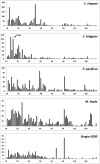A satellite explosion in the genome of holocentric nematodes
- PMID: 23638010
- PMCID: PMC3634726
- DOI: 10.1371/journal.pone.0062221
A satellite explosion in the genome of holocentric nematodes
Abstract
Centromere sequences in the genome are associated with the formation of kinetochores, where spindle microtubules grow in mitosis. Centromere sequences usually have long tandem repeats (satellites). In holocentric nematodes it is not clear how kinetochores are formed during mitosis; they are distributed throughout the chromosomes. For this reason it appeared of interest to study the satellites in nematodes in order to determine if they offer any clue on how kinetochores are assembled in these species. We have studied the satellites in the genome of six nematode species. We found that the presence of satellites depends on whether the nematode chromosomes are holocentric or monocentric. It turns out that holocentric nematodes are unique because they have a large number of satellites scattered throughout their genome. Their number, length and composition are different in each species: they apparently have very little evolutionary conservation. In contrast, no scattered satellites are found in the monocentric nematode Trichinella spiralis. It appears that the absence/presence of scattered satellites in the genome distinguishes monocentric from holocentric nematodes. We conclude that the presence of satellites is related to the holocentric nature of the chromosomes of most nematodes. Satellites may stabilize a higher order structure of chromatin and facilitate the formation of kinetochores. We also present a new program, SATFIND, which is suited to find satellite sequences.
Conflict of interest statement
Figures


Similar articles
-
Holocentric chromosomes.PLoS Genet. 2020 Jul 30;16(7):e1008918. doi: 10.1371/journal.pgen.1008918. eCollection 2020 Jul. PLoS Genet. 2020. PMID: 32730246 Free PMC article.
-
High evolutionary turnover of satellite families in Caenorhabditis.BMC Evol Biol. 2015 Oct 5;15:218. doi: 10.1186/s12862-015-0495-x. BMC Evol Biol. 2015. PMID: 26438045 Free PMC article.
-
The holocentric species Luzula elegans shows interplay between centromere and large-scale genome organization.Plant J. 2013 Feb;73(4):555-65. doi: 10.1111/tpj.12054. Epub 2012 Dec 12. Plant J. 2013. PMID: 23078243
-
Advances in the sequencing of the genome of the adenophorean nematode Trichinella spiralis.Parasitology. 2008 Jul;135(8):869-80. doi: 10.1017/S0031182008004472. Parasitology. 2008. PMID: 18598573 Free PMC article. Review.
-
Holocentric chromosomes: convergent evolution, meiotic adaptations, and genomic analysis.Chromosome Res. 2012 Jul;20(5):579-93. doi: 10.1007/s10577-012-9292-1. Chromosome Res. 2012. PMID: 22766638 Review.
Cited by
-
Holocentric chromosomes.PLoS Genet. 2020 Jul 30;16(7):e1008918. doi: 10.1371/journal.pgen.1008918. eCollection 2020 Jul. PLoS Genet. 2020. PMID: 32730246 Free PMC article.
-
High evolutionary turnover of satellite families in Caenorhabditis.BMC Evol Biol. 2015 Oct 5;15:218. doi: 10.1186/s12862-015-0495-x. BMC Evol Biol. 2015. PMID: 26438045 Free PMC article.
-
Evolution of Tandem Repeat Satellite Sequences in Two Closely Related Caenorhabditis Species. Diminution of Satellites in Hermaphrodites.Genes (Basel). 2017 Nov 28;8(12):351. doi: 10.3390/genes8120351. Genes (Basel). 2017. PMID: 29182550 Free PMC article.
-
Investigating the diversification of holocentromeric satellite DNA Tyba in Rhynchospora (Cyperaceae).Ann Bot. 2023 May 15;131(5):813-825. doi: 10.1093/aob/mcad036. Ann Bot. 2023. PMID: 36815646 Free PMC article.
-
Holocentromeres in Rhynchospora are associated with genome-wide centromere-specific repeat arrays interspersed among euchromatin.Proc Natl Acad Sci U S A. 2015 Nov 3;112(44):13633-8. doi: 10.1073/pnas.1512255112. Epub 2015 Oct 21. Proc Natl Acad Sci U S A. 2015. PMID: 26489653 Free PMC article.
References
-
- Melters DP, Paliulis LV, Korf IF, Chan SWL (2012) Holocentric chromosomes: convergent evolution, meiotc adaptations and genomic analysis. Chromosome Res 20: 579–593. - PubMed
-
- Beridze T (1986) Satellite DNA. Springer-Verlag, Berlin Heidelberg.
-
- Willard HF, Waye JS (1987) Hierarchical order in chromosome-specific human alpha satellite DNA. Trends Genet 3: 192–198.
-
- Hayden KE (2012) Human centromere genomics: now it’s personal. Chromosome Res 20: 621–633. - PubMed
-
- Hall AE, Keith KC, Hall SE, Copenhaver GP, Preuss D (2004) The rapidly evolving field of plant centromeres. Curr Op Plant Biol 7: 108–114. - PubMed
Publication types
MeSH terms
Substances
LinkOut - more resources
Full Text Sources
Other Literature Sources

